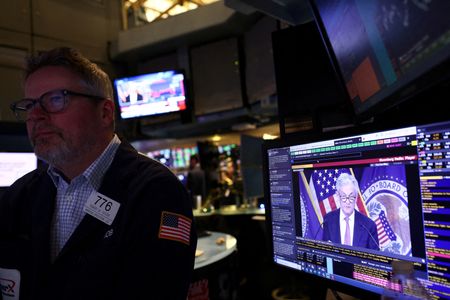By Jamie McGeever
ORLANDO, Fla. (Reuters) -The notion that higher interest rates would slam stocks has been turned on its head by Wall Street’s resilience to the most dramatic upward repricing of the U.S. rate outlook in decades.
More remarkable still, it is the areas most sensitive to higher borrowing costs – tech, the Nasdaq and growth stocks – that are outperforming in the face of soaring bond yields, implied rates and Fed expectations.
These sectors are more sensitive to rising yields because future cash flows and profits are discounted at higher rates. Tried and tested relationships are breaking down and correlations are crumbling.
The correlation between the Nasdaq and U.S. bond yields, for example, has been strongly negative for most of the last two years. But that has completely flipped, and the Nasdaq’s simple rolling 25-day correlation with two- and 10-year U.S. yields is now the most positive since last April.
What is behind the sudden turnaround?
Perhaps the most basic explanation is the U.S. economy is doing better than most people expected, as evidenced by the latest retail sales figures. It seems the recession that many predicted has not arrived, and more observers are wondering if it ever will.
According to Citi’s economic surprises index, incoming U.S. data is beating forecasts more than at any time since April last year. Better growth is good for earnings.
“If interest rates are rising because nominal growth is strong, companies’ revenue and pricing power can increase,” said Stephen Miran, co-founder at Amberwave Partners and a former Treasury advisor. “Higher interest rates are less bad for stock prices, even though rates can continue to weigh on multiples.”
Earnings growth estimates for S&P 500 companies this year have sunk to zero, which Miran believes could rebound if growth holds up. And looking ahead to next year, consensus forecasts are now penciling in earnings growth of almost 12%.
MORE TO GO
Market positioning is also a factor. According to Bank of America, investors’ exposure to U.S. equities at the start of the year was historically low, with fund managers the most underweight U.S. stocks since 2005.
BofA’s February survey of fund managers showed that bearish positioning relative to bonds has shifted a little this month, but is “still nowhere near optimistic enough to say positioning is a sell catalyst.”
In that light, it may just be the case that the most battered sectors of last year are getting more love from investors this year.
Look at the contrasting fortunes of growth and value stocks: the Russell 1000 Growth index plunged 30% last year and is up 12% so far this year, while the Russell 1000 Value index fell 10% last year and is up only 5% year to date.
Alternatively, a big-picture macro explanation might be boiled down to a single word: liquidity. Despite the global rise in interest rates and move toward ‘quantitative tightening’ last year, major central banks are actually pumping huge amounts of liquidity into the global financial system.
TEXTBOOK STUFF
Whatever the reasons, the market moves have been startling.
Since the Fed met on Feb. 1, the two-year Treasury yield has risen more than 50 basis points, the yield on six-month bills and implied rate on December 2023 ‘SOFR’ rate futures have hit 5% and talk of the terminal rate reaching 6% is suddenly no longer unhinged.
JP Morgan’s Marko Kolanovic estimates that the move in two-year yields since the Fed meeting should result in a 5% to 10% sell-off in the Nasdaq, which is actually up 3.5% since.
In the first six weeks of this year the Nasdaq is up 15% and the Russell 1000 Growth index is up 12%. Crypto, speculative tech and meme stocks are up even more.
Compare that with the Dow and S&P 500 which are up 2% and 7%, respectively, and the Russell 1000 Value index’s 5% rise.
Kolanovic puts this down exuberance, greed and complacency. The speculative element to the market’s strength is reflected in the surge in retail investor volumes which he says are near record highs, accounting for over 20% of all market activity.
But this is unlikely to continue – holding short-term bonds over stocks is more attractive now than any time since the Great Financial Crisis, he says.
If Fed action on rates meets or exceeds market expectations investors will have to rethink, and a move away from lower quality, high duration equities may soon get underway.
“The textbooks have not been rewritten. In a higher rate regime, profitability matters. Fundamentals will start to catch up,” says Matt Orton, chief market strategist at Raymond James Investment Management.
(The opinions expressed here are those of the author, a columnist for Reuters.)
Related columns:
– Faced down by Fed, markets dab 6% onto risk radar
– Wall St rip finds few fans at Miami hedge fund week
– Low visibility, low volatility make strange pairing
– Outsized U.S. share of world equity may revert to norm
(By Jamie McGeever; Editing by Josie Kao)

